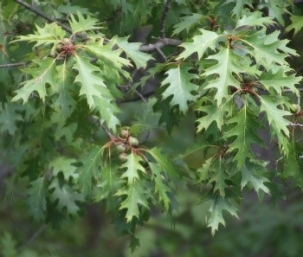Northern red oak (Quercus rubra; Chêne rouge d’Amérique) is the official tree of Prince Edward Island but also native to the Montreal area (Government of Canada, 2017). The deciduous tree was almost been driven to extinction due to its exploitation for furniture in Prince Edward Island, but it is still commonly found throughout southeastern and eastern Canada.
Identifiable by its reddish-brown cupped acorns and bark, the Red oak also has green wedge-shaped oblong leaves with seven to nine lobes that turn into red colors in fall seasons (Arbor Day Foundation, n.d.).
Red oaks generally are good urban trees: their moderate level of tolerance to salt exposure makes them a good option for roadsides (Wynnyczuk,n.d.).
Red oaks provide habitat for Blue jays and squirrels in urban areas but also food for deer and black bears in less urban areas. Red oak acorns contain tannins that make them taste bitter, but gray squirrels prefer them to White oak acorns, which taste less bitter (Tirmenstein, 1991).
While the red oak has its own advantages, it is also very susceptible to the spongy moth, winter moth, and forest tent caterpillars, the free-living defoliators that cause the most damage to Canadian trees (Government of Canada, 2015).
Some of the largest trees on the Loyola campus are Red oaks located between the football field and the Montreal Asociation for the Blind. The largest of these was last measured at 93 cm in diameter at breast height; based on a growth factor of 4.0 for this species (Purcell, 2018), that makes this tree about 146 years old. According to the iTree model, this tree currently stores over 3100 kg of carbon. It also filters the air and water and provides countless other ecosystem services.
References
- Arbor Day Foundation. (n.d.). Northern Red Oak. Arbor Day Foundation. Retrieved January 29, 2023, from https://www.arborday.org/trees/treeguide/treedetail.cfm?itemID=877
- Government of Canada, Natural Resources Canada. (2015). Red oak. Government of Canada, Natural Resources Canada. Retrieved January 26, 2023, from https://tidcf.nrcan.gc.ca/en/trees/factsheet/66
- Government of Canada. (2017, August 15). Prince Edward Island’s provincial symbols. Retrieved January 29, 2023, from https://www.canada.ca/en/canadian-heritage/services/provincial-territorial-symbols-canada/prince-edward-island.html
- One Tree Planted. (n.d.). Types of Tree Species. One Tree Planted. Retrieved January 29, 2023, from https://onetreeplanted.org/pages/types-of-trees-species
- Purcell, L. (2018). How old is my tree? Purdue University Landscape Report, 18-04. https://www.purduelandscapereport.org/article/how-old-is-my-tree/
- Tirmenstein, D. A. (1991). Quercus rubra. In: Fire Effects Information System, [Online]. U.S. Department of Agriculture, Forest Service, Rocky Mountain Research Station, Fire Sciences Laboratory (Producer). Retrieved from January 29, 2023 https://www.fs.usda.gov/database/feis/plants/tree/querub/all.html
- Wynnyczuk, P. (n.d.). What Does Road Salt Do To Our Trees? - P & A Urban Forestry. P & A Urban Forestry Consulting Ltd. Retrieved January 30, 2023, from https://www.paurbanforestryconsulting.com/what-does-road-salt-do-to-our-trees/


 Northern red oak leaves
Northern red oak leaves